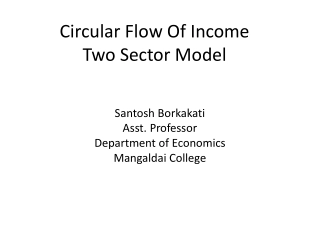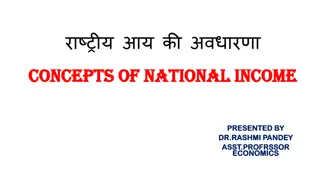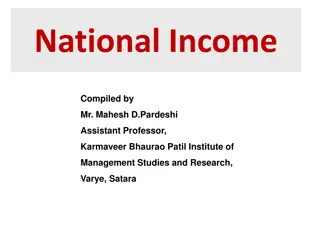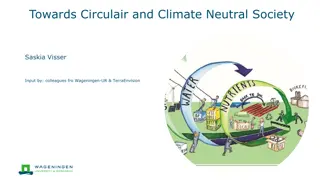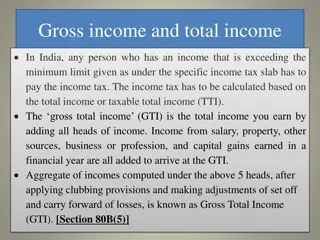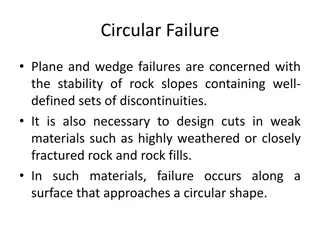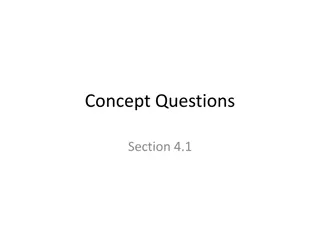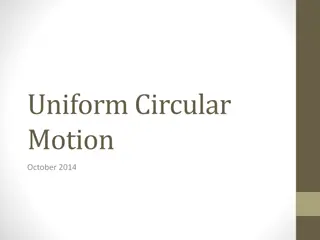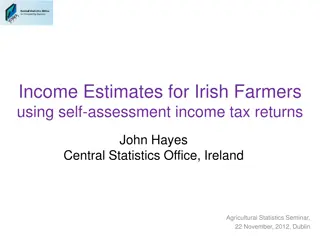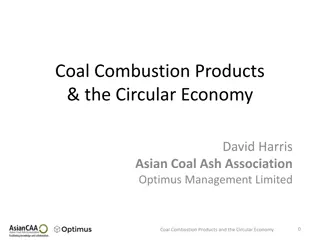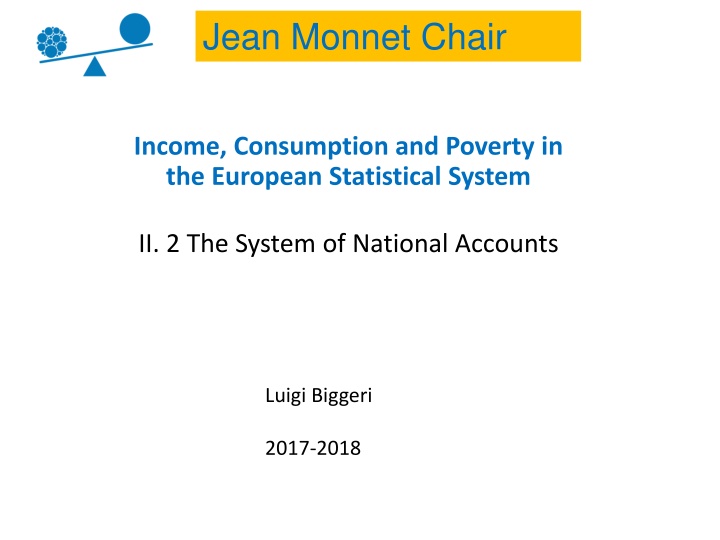
Overview of Circular Flow of Income in Economic Systems
The circular flow of income model in economics illustrates the exchanges of money, goods, and services among economic agents like households and firms. This model forms the basis of National Accounts and helps in understanding the flow of production, consumption, and income distribution in closed economies. Explore this model through examples and detailed explanations of income generation and distribution.
Download Presentation

Please find below an Image/Link to download the presentation.
The content on the website is provided AS IS for your information and personal use only. It may not be sold, licensed, or shared on other websites without obtaining consent from the author. If you encounter any issues during the download, it is possible that the publisher has removed the file from their server.
You are allowed to download the files provided on this website for personal or commercial use, subject to the condition that they are used lawfully. All files are the property of their respective owners.
The content on the website is provided AS IS for your information and personal use only. It may not be sold, licensed, or shared on other websites without obtaining consent from the author.
E N D
Presentation Transcript
Jean Monnet Chair Income, Consumption and Poverty in the European Statistical System II. 2 The System of National Accounts Luigi Biggeri 2017-2018
Outline Not all the accounts and aggregates of the System of National Accounts are presented in details. The presentation is limited to the elements useful for the study of the income at disposal of the households at aggregate level and to the Indicators which it is possible to compile 1. The circular flow of the economy 2. The system of NA: Basic Equations and Identities (Accounts) 3. Aggregates of interest 4. Household Sector and Consumption 5. Sub-System of NA: Labour Accounts 6. Regional Accounts 2
1 The circular flow of Income -a- The circular flow of income or circular flow is a model of a closed economy in which the major exchanges are represented as flow of money, goods and services, etc. between economic agents Income produced (Y) Intermediate consumption (IC) Income distributed (Y) 3
1 The circular flow of Income -b- Only two agents or sectors (Households and Firms) are considered in this simple circular flow of Income (for a closed economy) The flows of money and goods exchanges is a closed circuit and correspond in value, but run in opposite direction The circular flow analysis came from macroeconomic theory and it is the basis of National Accounts The output (O) of the firms is the production of goods and services for which they need the factors for production (labour, capital and organization capability) and the intermediate consumption (IC) Y = O - IC 4
1 The circular flow of Income simple example - - Output (O) = 100 Total production of goods and services - Intermediate Consumption (IC) = 30 goods and services used for the production - Income produced (Y) or Value Added = O IC = 70 - Income distributed (Y) 70 = Wages, Dividents and Rents In the next slide a more complex five sector model is presented (Households, Firms, Financial Sector, Government Sector, Overseas Sector) 5
EXAMPLE OF A FIVE SECTOR MODEL N.B the symbols represent the corresponding sectors or flows 6
2 The system of National Accounts -a- Definition of the System of National Accounts A comprehensive and systematic, quantitative description of economic phenomena in a country, related to a certain period of time, to give an overall picture of its economy Why National Accounts? Relevant for: Economic theory and basis for Model building Monitoring the performance of an economy with a consistent set of indicators Basis for coherent policy formulation (and evaluation) and for monitoring and forecasting the effects of the socio-economic policies Gives a possibility of comparisons between years and countries (for international and intra-national comparisons) 7
2 The system of National Accounts -b- Objective Give a complete overview of the various economic processes within an economic territory Production, consumption, capital formation Income distribution and redistribution Flow of funds (financial processes) Accumulation of wealth Relations between sectors and with the rest of the world *of interest for poverty analysis The core of the system of National Accounts National Accounts is a consistentsystem with identities (definitional equation) and accounts, for each economic process Uniform concepts, definitions and accounting rules (SNA 2008 and ESA 2010) 8
2 The system of National Accounts c- Two basic kinds of information in the system: Stocks: holdings of assets and liabilities at a point of time --> recorded in balance sheets Flows: reflect creation, transformation, exchange, transfer or extinction of economic value --> recorded in all other accounts of the system --> two kinds of economic flows: transactions other changes in assets 9
2 The system of National Accounts: Basic Identities -a- Basic Identities (equations) and Accounts Definition of aggregates GDP = Gross Domestic product M = Imports C = Consumption of Households G = Government Expenditures I = Investments X = Exports O = Output (Production) IC = Intermediate Consumption 10
2 The system of National Accounts: Basic Identities -b- Basic Identities (equations) and Accounts: Production Account The basic idea: supply and demand are equal GDP + M = C + G + I + X <=> GDP = C + G + I + (X - M) Also: O + M = IC + C + G + I + X Definitional equations: transaction identity (for transactions between units) total uses = total resources budget identity total liabilities = total assets 11
Example of Production Account for Italy (GDP) Indicators to evaluate the development GDP per capita or per unit of labour 12
3 Aggregates of interest: Production Aggregates Aggregates of interest for analysis of poverty are presented Definition of Production An activity carried out under the control and responsibility of an institutional unit that uses inputs of labour, capital and goods and services to produce outputs of goods and services. Production does not cover purely natural processes without any human involvement or direction, (ESA95) Same definition can be found in ESA 2010 Value added (gross) GDP = difference between output and intermediate consumption = income generated with production = compensation of employees wages and salaries social contributions + operating surplus and mixed income + consumption of fixed capital 13
3 Aggregates of interest: Income aggregates Gross National Income (GNI) = gross domestic product + primary income received from the rest of the world - primary income paid to the rest of the world Primary income (Distribution and redistribution of Income) - wages and salaries, social contributions (these together equal compensation of employees) interest, dividends taxes on production and imports subsidies - - - Household Disposal Income (also for international comparisons, per person or per household) 14
3 Aggregates of interest: Final Expenditure Final Expenditure Exports and imports (foreign trade) Consumption of households Consumption of government and NPISH Gross capital formation (Investments) Final expenditure: Consumption (C + G) Final consumption expenditure Actual final consumption: In the economy as total: final consumption expenditure = actual final consumption Actual individual consumption is used for international comparisons For International Comparisons the value of the aggregate per capita is used (example Consumption per capita, or per household) 15
4 Main Sectors in NA: Household Sector Classification of institutional sectors S11 Non-financial corporations S12 Financial corporations S13 General government S14 Households S15 Non-profit institutions serving households (NPISH) S2 Rest of the world (ROW) The most important NA Sector for the analysis of poverty is the Household Sector 16
4 Household Sector -a- Content 1. Definition of households 2. Principal roles of households 3. Institutional units 4. Institutional sector 5. Households sector 6. Households sub sectors 1. Definition of households Small groups of persons who share the same living accomodation who pool income and wealth who consume certain types of goods and services collectively, mainly housing and food 17
4 Household Sector -b- 2. Principal roles of households Consumers (final consumption) Employees (supply of labour) Producers (production of market goods and services, unincorporated producers/ enterprices) 3. Households are institutional units Institutional units are economic entities that are capable of: owing goods and services incurring liabilities engaging in economic activities and transactions with other units in their own right 18
4 Household Sector -c- 4. Institutional sector Resident institutional units grouped together into mutually exclusive sectors according to their economic behaviour The households sector consists of all resident households 5. Households sector includes: Households whose principal function is consumption Household producers for exclusively own final use Sole proprietorships and partnerships without legal status that are market producers (other than quasi-corporations) Persons living permanently in institutions (institutional households) 19
4 Household Sector -d- 6. The households sector is subdivided in: Employers and own-account workers Employees Recipients of property incomes Recipients of pensions Recipients of other transfer incomes Criterion of inclusion in the different aggregates: the largest income category of the household as a whole 20
4 Household Sector -e- Data Sources Data Sources for estimate the aggregates Direct sources Household surveys (for current accounts) Central Banks (for financial accounts) Fiscal data (for own account workers) Indirect sources - Social economic reports Fiscal data Business registers / production statistics Social security funds Institutional investment schemes In general: data of other sectors 21
4 Household Sector Consumption -a- Consumption of households: definition Goods and services Consumption of own production Barter (exchange) Second hand purchases Tourism: domestic versus national concept Consumption of households: sources of data Retail trade survey (RTS) Household budget survey (HBS) 22
4 Household Sector Consumption -b- Methods of computation It is impossible to compute the value of NA Aggregate using only one source of data Reconciliation of RTS and HBS - make population and valuation consistent - turnovers from RTS - market shares from HBS (specification by type of outlet) Paid for by households directly of indirectly - examples: housing, financial and medical services Many consumption items based on mixture of sources - examples: utilities, energy, transport, cultural & social services 23
5 The enlarged system of N A: Labour accounts The system of National Accounts has been enlarged to show other flows and included other sectors: for this course the Labour accounts are of interest because are related to the distribution of wages, etc. Labour accounts (important for the evaluation of income distribution and poverty) See next slides Integrated dataset on labour and wages Consistency with corresponding data in sector accounts and supply and use tables* (not presented here) Examples: data on population and labour force, employment (hours worked, number of jobs, number of employees/self employed), compensation of employees Also the Social Account Matrix (SMA) is very important for the analysis of the income distribution, but it is too complex to be presented in this course 24
5 Labour Accounts -a- Content 1. Concepts International guidelines Employment Compensation of employees (and mixed income) 2. Labour Accounts Frameworks Data confrontation Labour market dynamics Price and volume measurement 3. Key data sources Labour force survey Employees registers 25
5 Labour Accounts -b- Employment measures: Total hours worked Includes: Work of employees and self-employed; Contractual hours and (un)paid overtime; Work time spent on training; Coffee/tea breaks. But excludes: Hours paid for, but not worked such as holidays and sick leave; Meal breaks; Time spent on commuting; Education other than training. 26
5 Labour Accounts -c- Flows of demand and supply Categories of Jobs and Persons in the labour market The labour market Jobs Persons demand employed occupied supply vacancies unemployed inactive Industry branch Main income category (wages, mixed income, benefits, none,...) 27
Example of Sequence of accounts on the distribution of income II.1.1 Generation of income account (for all sectors excluding ROW) U R Compensation of employees 238,8 Net domestic product (market prices) 395,8 Taxes on production and imports 58,9 Less: subsidies -8,2 B2n = Operating surplus or mixed income 106,3 395,8 395,8 28
Sequence of accounts II.1.2 Primary distribution of income (for all sectors excluding ROW) U R Operating surplus or mixed income Property income 222,9 106,3 Compensation of employees 238,6 Taxes on production and imports 56,4 Less: subsidies -6,9 B5n = Net national income 400,3 Property income 228,8 623,2 623,2 29
Sequence of accounts II.2 Secondary distribution of income (for all sectors excluding ROW) U R Net national income 400,3 Current taxes on income, wealth 52,3 Current taxes on income, wealth 53,2 Social contributions 115,0 Social benefits 81,4 Social contributions 115,4 Other current tranfers 122,2 Social benefits 79,9 B6n = Net disposable income 393,7 Other current tranfers 115,8 764,6 764,6 30
Sequence of accounts II.4 Use of income account (households, government and NPISH) U R Net disposable income 393,7 Final consumption expenditure 343,2 Adjustment for change in net equity of households on pension funds Adjustment for change in net equity of households on pension funds 19,4 19,7 B8n = Net saving 50,8 413,4 413,4 31
8. Regional Accounts We are interested in designing and implementing poverty policies at regional level. In this case as general framework it is possible to use the Regional Accounts that are derived by the National Accounts Background: Why Do Regional Accounts Exist? Data on national accounts is not enough An input for decision-making Regional policy and development Analysis, monitoring and forecasting Research Basic Concepts Regional accounts are a regional specification of the corresponding accounts of the national economy Same basic concepts than in National Accounts Regional Accounts make regional economic structures, disparities and development visible 32
References for National Accounts Most of the slides here presented are taken by the documentation used in the European Statistical Training Programmes hold during the last four years Main references - Measuring the Economy: A Primer on GDP and the National Income and Product Accounts, (http:/bea.gov/NATIONAL/PDF/NIPA_PRIMER.PDF), by Bureau od Economic Analysis (BEA), US - Richard Stone: Definition and measurement of the National Income and related tools , 1947 - United Nations, System of National Accounts: SNA 1953, 1968, 1993 and now 2008 - Eurostat, European System of Accounts: ESA 1970, 1979, 1995 and now 2010 (look only to the chapters and paragraphs regarding the topics presented in the slides) 33
References for Labour Accounts International Guidelines SNA 2008 Chapter 7 Distribution of income compensation of employees, mixed income Chapter 19 Population and labour inputs labour force, labour inputs, productivity, data sources ESA 2010 Chapter 4 Distributive transactions compensation of employees Chapter 11 Population and labour accounts (un)employment, jobs, non-observed economy, labour input, labour input at constant prices, productivity 34

